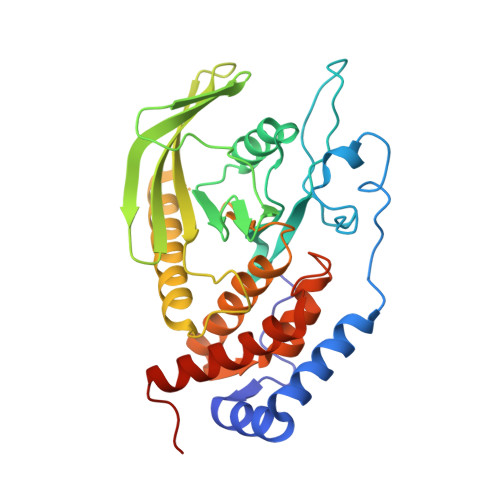A Highly Selective and Potent PTP-MEG2 Inhibitor with Therapeutic Potential for Type 2 Diabetes.
Zhang, S., Liu, S., Tao, R., Wei, D., Chen, L., Shen, W., Yu, Z.H., Wang, L., Jones, D.R., Dong, X.C., Zhang, Z.Y.(2012) J Am Chem Soc 134: 18116-18124
- PubMed: 23075115
- DOI: https://doi.org/10.1021/ja308212y
- Primary Citation of Related Structures:
4GE2, 4GE5, 4GE6 - PubMed Abstract:
Protein tyrosine phosphatases (PTPs) constitute a large family of signaling enzymes that control the cellular levels of protein tyrosine phosphorylation. A detailed understanding of PTP functions in normal physiology and in pathogenic conditions has been hampered by the absence of PTP-specific, cell-permeable small-molecule agents. We present a stepwise focused library approach that transforms a weak and general non-hydrolyzable pTyr mimetic (F(2)Pmp, phosphonodifluoromethyl phenylalanine) into a highly potent and selective inhibitor of PTP-MEG2, an antagonist of hepatic insulin signaling. The crystal structures of the PTP-MEG2-inhibitor complexes provide direct evidence that potent and selective PTP inhibitors can be obtained by introducing molecular diversity into the F(2)Pmp scaffold to engage both the active site and unique nearby peripheral binding pockets. Importantly, the PTP-MEG2 inhibitor possesses highly efficacious cellular activity and is capable of augmenting insulin signaling and improving insulin sensitivity and glucose homeostasis in diet-induced obese mice. The results indicate that F(2)Pmp can be converted into highly potent and selective PTP inhibitory agents with excellent in vivo efficacy. Given the general nature of the approach, this strategy should be applicable to other members of the PTP superfamily.
- Department of Biochemistry and Molecular Biology, Indiana University School of Medicine, 635 Barnhill Drive, Indianapolis, Indiana 46202, USA.
Organizational Affiliation:

















